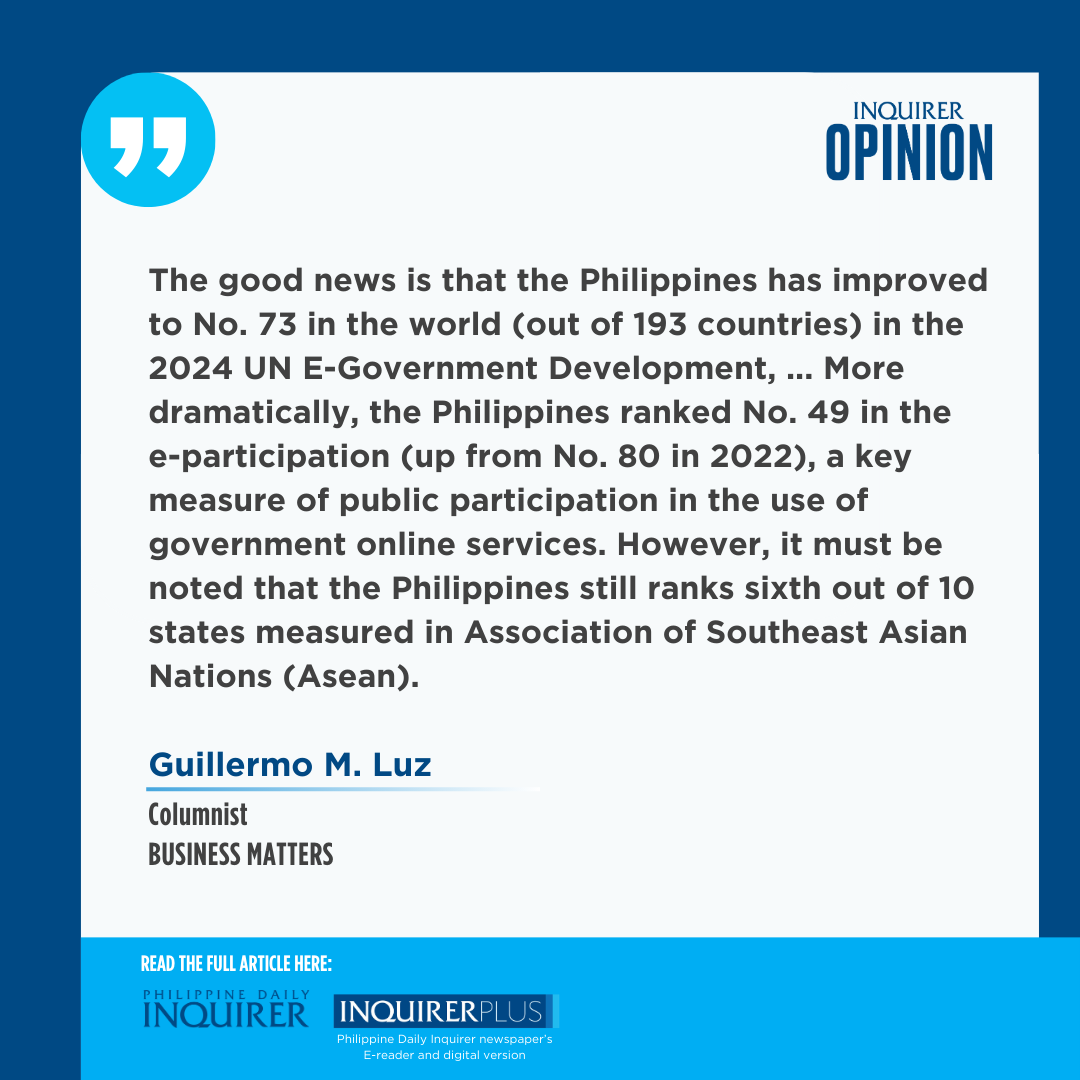We’ve long advocated that we should regularly monitor where we stand on various global competitiveness reports being issued periodically in the belief that “what gets measured, gets managed.” Thus, last December 2023, the Rizalino S. Navarro Policy Center for Competitiveness at the Asian Institute of Management and Liveable Cities entered into an agreement with the Anti Red-Tape Authority to establish the Philippine Global Competitiveness Report Card. The Department of Trade and Industry later joined the project and we launched the project on a website in May 2024. The website can be accessed on www.arta.gov.ph/competitiveness.
The site tracks 20 different global reports distributed across seven major categories: digital; general competitiveness; education, talent, and innovation; trade; energy and environment; governance; and health and nutrition. Since the site’s launch, five new reports have been released—the IMD World Competitiveness Yearbook; IMD World Talent Ranking; the United Nations (UN) E-Government Development Index; the World Bank’s B-Ready Report; and the Global Hunger Index.
For today’s column, let’s explore how the country performed in the UN E-Government Development Index. This report tracks how all 193 members of the UN are performing in terms of e-government readiness. The report has been around since 2001 and is published once every two years. The index is composed of three sub-indices, each given an equal weight: online services index (OSI); telecommunication infrastructure index (TII); and the human capital index (HCI).
Under the OSI, government portals are evaluated based on institutional framework, services provision, content provision, technology, and e-participation.
Under the TII, aspects of infrastructure such as affordability, mobile-cellular telephone subscriptions, mobile-cellular broadband subscriptions, and individuals using the internet are measured.
For purposes of e-governance, the HCI is a measurement of adult literacy, gross enrollment ratio, expected years of schooling, mean years of schooling, and e-government literacy (a measure of the population’s ability to use e-government services and participate online).
The good news is that the Philippines has improved to No. 73 in the world (out of 193 countries) in the 2024 UN E-Government Development, up from No. 89 in the 2022 report. This brings the Philippines close to its peak (No. 71 in 2016) and represents a major improvement in ranking by 16 spots in the last two years. More dramatically, the Philippines ranked No. 49 in the e-participation (up from No. 80 in 2022), a key measure of public participation in the use of government online services.
However, it must be noted that the Philippines still ranks sixth out of 10 states measured in the Association of Southeast Asian Nations (Asean). Singapore, not surprisingly tops Asean by ranking No. 3 in the world, followed by Thailand (No. 52), Malaysia (No. 57), Indonesia (No. 64), Vietnam (No. 71), Philippines (No. 73), Brunei (No. 75), Cambodia (No. 120), Myanmar (No. 138), and Laos (No. 152). This is a recurring pattern for the Philippines across many global competitiveness reports—typically ranking fifth or sixth out of the 10 Asean states.
The report gave the Philippines a score of 0.7621 (out of a maximum of 1.0) in the E-Government Development Index. This was a significant improvement over its score of 0.6523 in 2022 but nonetheless shows there is still great room for improvement. It noted that the Philippines has focused on digital transformation in sectors like health, education, and finance.
It is worth noting that Vietnam, which is slightly ahead of the Philippines at No. 71, attributes part of its progress on significant investments in digital public services. Indonesia, at No. 64, attributes part of its success on investments in information and communications technology infrastructure and digital literacy programs.
The report suggests that the Philippines should prioritize human capital development by investing in digital skills and digital literacy for its people in order to raise its scores in the overall e-government ranking.
Credit should go to the Department of Information Communications Technology and to the telecommunications industry for lifting the Philippines’ score and ranking.
The value of these reports is that we can compare ourselves against our immediate competitors and see where and how we can make improvements. From our position in the middle of the pack in one of the most competitive regions in the world—Asean—we’re going to have to work doubly hard to catch up and overtake our competition.
And remember, the competition never sleeps.
—————-
Guillermo M. Luz is chair of the advisory board of the Rizalino S. Navarro Policy Center for Competitiveness at AIM.
—————-
Business Matters is a project of the Makati Business Club (makatibusinessclub@mbc.com.ph).
